STOP THE SMELTER!
Please Sign Our Petition by Clicking Here!
I have been asked to post the letter I sent to the Planning and Zoning Commission members. I created this letter so that the Commissioners would have facts when considering Alliance Metals request for a minor amendment to the Comprehensive Plan and their rezoning request.
I am not the only one who prepared such a document. I am aware of at least two other letters from residents and one from Don’t Waste Arizona. All four of these letters have presented fact based reasons why the proposed location for the smelter is in the wrong place. I apologize in advance for the length; however, there are a lot of issues to be addressed and you can find some of this information on various parts of the website.
Prepared for La Paz County Supervisors, Director of Community Development and the members of the Planning and Zoning commission.
November 12, 2019
Please convey this document to the members of the Planning and Zoning Commission prior to their December 5thmeeting. This is information regarding why I oppose the approval of the rezoning and minor amendment application from Alliance Metal Southwest, LLC for the property located at 70050 US 60 in Wenden Arizona.
I am a long time resident of Wenden, Arizona and I currently serve as the President of the Wenden Elementary School Governing Board and as Chairman of the Board of Directors for Wenden Domestic Water Improvement District. I strongly oppose this development and ask that the Planning and Zoning Commission vote to NOT approve the rezoning and minor amendment application. This type of facility does not belong in a population center but should be at least 25 miles from one. This is the wrong location for this type of facility.
I do not believe that Alliance Metal Southwest or their law firm, Rose Law Group; have been forthcoming with either the public or with the County in presenting their application. They have not expressed the true nature of their development, a secondary aluminum recycling smelterand have not done their proper due diligence regarding the plants impact on the environment, the aquifer and the health and welfare of the residents of the community.
In fact, the company has never held community meetings for residents of either Wenden or Salome. They did not reach out to the elected officials in Wenden or Salome to discuss or explain their plans and listen to the concerns of the residents prior to making the purchase of the land, applying for an Air Quality Control permit with ADEQ or attempting to have the property rezoned.
The ADEQ public hearing regarding their application was held in Wenden on September 4ththis year. Even though the winter residents had not yet arrived in the valley the meeting was attended by approximately 150 people. Fifteen people registered to speak and every single speaker was adamantly opposed to the project. No one spoke in favor of it. An overwhelming number of the residents in Salome and Wenden oppose this facility in the selected location. The company and their representative with Rose Law Group did not meet with anyone in the community until after they became aware that there was major opposition in Salome and Wenden. That was when they chose to meet with myself. This meeting was at their request as they identified me as the most knowledgeable and outspoken resident. The meeting was eye opening with regard to the lack of planning, understanding and grasp of the project. There have been no additional meetings.
Overall, most people in the Salome/Wenden area welcome new businesses that enrich the community and the quality of life, through job creation, county revenue and work culture. The economy in eastern La Paz County is driven by: agriculture, tourism, winter visitors and residents. Unfortunately, not all proposed new businesses will contribute to community enrichment through sustainable economic growth. In fact, some businesses can have a significant negative impact on the area that can devastate the economy, the environment above and below the ground and cost taxpayers a considerable amount of money for remediation.
The Highway 60 corridor between Wenden and Salome is the most desirable area for future growth in the Valley. It is the “main street” for the two towns and supports the livelihood and visual appeal for the two communities.
Modern day planning methods place industrial zoning far beyond city-town population centers due to the negative impacts industry has historically had on property values, human and environmental health.
The building of an aluminum recycling smelting business poses unsustainable economic development and environmental hazards for human, agriculture and desert wild life. It should be noted that the Wenden Domestic Water Improvement District Board of Directors and the Wenden Elementary Governing Board both passed resolutions stressing opposition to this project in this location. They both passed these resolutions once the risks of the project became clear. While these resolutions are not legally binding, they reflect the opinion of the only elected officials in Wenden.
Looking at the application Alliance submitted as part of the rezoning request you would think that this is a simple recycling facility similar to Ecology. This is far from the truth. This facility, while they intend to recycle aluminum, is what the EPA calls a secondary smelter. The recycling effort is the melting of contaminatedraw aluminum scraps at over 1,500 degrees Fahrenheit, into ingots and t-bars for shipping to their customers. In the process there are some inherently dangerous processes and chemicals that prudence would dictate it be located away from a population center. Not within the town limits of Wenden. No matter what language is used, this is not a “green” facility in the sense that most of us understand. Smelting metal is not a “green” activity. This is an attempt at making this project sound benign. The risks, that I will outline here, far outweigh any benefit that the facility would bring to the County and the Community.
The following items are the reasons why I oppose this project at the site Alliance has selected.
AIR POLLUTION
- For all of the claims that Alliance Metals is making about state of the art equipment, latest technology, extra measures, environmentally friendly, etc. the fact remains that the facility will pollute the air in McMullen Valley. The issuance of the Air Quality Control permit does not have any bearing on whether the plant will pollute or not. It simply limits the amount that can be emitted. It will pollute the air. Stated in the company’s application to ADEQ and in the Air Quality Control permit, the facility will emit nitrogen oxides, particulate matter (including aluminum bits), carbon monoxide, sulfur dioxide, lead and hazardous air pollutantsincluding dioxinsand furans. (Think Agent Orange) The total amount of hazardous emissions annually will be 35 tons per year, as stated in ADEQ’s Technical Review and that’s even with all the emission control measures that the company touts, and ADEQ requires applied. Dioxins and furans are the most toxic compounds to animals and humans known to man. In fact, in September of 1994, the EPA issued the results of a study and determined that “there appears to be no ‘safe’ level of exposure to dioxin.”
- While Alliance would like you to think that “This use is NOT a noxious use of any kind because the processing or “secondary recycling” (which is code for smelting) of aluminum scraps will occur within an enclosed facility.” While some of the pollutants will be captured in the plants baghouse/lime filtration system 35 tons per year of hazardous pollutants will be vented into the air.
- In their application they state, “that the cotton gin had very high emissions negatively impacting air quality”. That is an irrelevant and misleading comparison. While the cotton gin did have a negative impact on air quality the emissions were restricted to particulate matter. The cotton gin has not been active for more than two decades and did not run 12 months per year. Alliance is planning on running this plant 24/7 as they state in their application to ADEQ. The biggest difference between a smelter and the cotton gin is that the cotton gin did not emit 35 tons per year of nitrogen oxides, carbon monoxide, sulfur dioxide, lead and hazardous air pollutants including dioxins and furans. (As stated in their application to ADEQ and the subsequent Air Quality Control permit.) The particulate matter that the smelter will emit is aluminum, which in this form is very dangerous to humans and animals and will pollute the soil. That was not the case with the cotton gin.
- The company’s application states that this facility will be environmentally sensitive “because the State highly regulates processing facilities.” In the Air Quality Control permit issued by ADEQ, it is stated that the company will self-monitor. That means that all testing and reporting is up to the company to regulate and monitor without any outside third party monitoring and no physical monitoring by ADEQ. Policing themselves with this level of potential hazards is simply not protecting the community and has no credibility. In another example of less than being highly regulated, the permit calls for the company to test their dioxin and furan emissions within the first 180 days after start up and then not again for two years! This does not ensure the safety of public health.
- “In addition to ADEQ routinely monitoring the facility, (which is misleading), Alliance Metals agrees to go one step further and subject its operation to a monitoring program that will be overseen by La Paz County to ensure air and water quality remain at optimal levels.” This is an empty concession since the county does not have the staff or the expertise to monitor the facility. Nor does the county have the authority or permission from the EPA to do so. That should be done by ADEQ but ADEQ will only be monitoring the reports that Alliance sends them after they do their own testing.
- ADEQ ran wind dispersion modeling samples using the EPA’s AERMOD program to determine the potential spread of the pollutants. According to ADEQ’s technical review, page 10, Section G, the emitted pollutants would fall: “within or near the facility fenceline.” As stated in the technical review, the meteorological data used to create this model came from Agulia. The data used for the background concentration of particulate was from Lake Alamo, an area devoid of the particulate contamination from farm activity, which exists at the proposed site. The balance of the data used was from Tucson and Blythe, CA. It is our belief that the data used for the modeling does not accurately represent the conditions of the proposed site. With the winds that blow in the valley, it is not credible to think that most of the concentrations of the pollutants would fall within or near the facility fenceline. There is nothing they can do to prevent polluting the air and the soil.
- According to the EPA, this facility requires MACT (Maximum Achievable Control Technology) for its emissions of dioxins and furans, not BACT (Best Available Control Technology) as proposed in the permit. “Secondary Aluminum Production facilities as area sources are subject to MACT for Dioxins and Furans.” As stated on EPA’s website. According to the EPA, pressure drop monitoring and leak detection systems for the baghouse are necessary and require continuous monitoring and consistent calibration schedules to meet the MACT standard. A continuous monitoring system such as bag Leak Detection System along with effective pressure drop monitoring must be required for the baghouse to meet MACT standards. ADEQ is only requiring the company to comply with BACT, not MACT. Even though ADEQ has the ability to enforce stricter controls on the facility they have chosen not to do so.
- The projected particulate matter emissions are aluminum and other metals that have a disproportionate toxicity and these can accumulate downwind in soils and dwellings. This contamination will render much of the surrounding properties toxic and unfit for farming as they are currently used.
- The mission statement for ADEQ is to “protect and enhance the environment and public health.” In that mission, ADEQ should be concerned about, our volunteer fire department, which is not trained or equipped to handle a HAZMAT emergency. For example, what happens is there if a catastrophic accidental release of chlorine gas? What happens is there is a fire involving the salt cake and other toxic materials? The first responders would only be able to set up a perimeter and call ADEQ for a HAZMAT unit form Lake Havasu City or Phoenix. (The dangers of chlorine and salt cake are discussed later in this document.)
HAZARDOUS MATERIALS
- The Air Quality Control permit allows the facility to operate illegally as a hazardous waste disposal facility. The application for the permit clearly states that the facility will be accepting and processing aluminum dross. Aluminum dross is considered a hazardous wasteby the EPA. Because this facility would be utilizing what is termed as “unclean charge” including aluminum dross, by law there needs to be in place a system, process, procedure and proper recordkeeping that can identify, sort and dispose of aluminum dross for its hazardous characteristics of ignitability and reactivity. ADEQ has not addressed this issue nor has the company. To legally accept aluminum dross that is a hazardous waste, the facility would need a hazardous waste permit. If the aluminum dross that is accepted at the facility does not have proper certification then that aluminum dross cannot be legally used as feedstock to the process. This omission allows a hazardous waste disposal facility within the town limits of Wenden. This is inherently unsafe.
- The presence and use of 30,000 gallons of chlorine represents an unprecedented and unwarranted risk to the residents and children of the Valley to say nothing of the livestock. Locating this in a population center represents a risk that we should not be forced to accept. A recent chlorine leak in a Chandler industrial park shows just how dangerous chlorine can be. It caused the evacuation of area businesses and disrupted traffic for hours. Fortunately there were no people injured this time. That leak was from a puncture in a container holding 1,500 pounds or about 150 gallons of chlorine. The amount of chlorine that would be kept at this facility is to be 300,000 pounds, 200 times more than the leak in Chandler. The quantity of 30,000 gallons is the amount that the company stated in their application with ADEQ. There have been subsequent comments made that they would use two 5,000-gallon tanks, which does not diminish the risk. The only official quantity is in their ADEQ application stating 30,000 gallons.
- In the event of a catastrophic chlorine spill and assuming a mild 10 mph wind blowing toward Wenden, the edge of the town would be exposed to a chlorine gas cloud with a concentration of 1,000 parts per million in just four minutes and the entire town would be exposed to 4,000 parts per million within six minutes.According to the CDC, exposure of 1,000 parts per million will be lethal, 4,000 parts per million is immediately lethal. Four minutes is not enough time to evacuate the town let alone the school. It might be noted that there are no HAZMAT suits or masks for children.See attached illustration exhibit 1. These wind dispersion models were created using ALOHA, the program that EPA uses to model wind dispersion from chemical spills.
- To protect the residents and livestock in the area there should be chlorine monitors placed all around the property. There should also be a response plan for the plant and the community in the event of a leak as well as an alarm system set up in both Salome and Wenden to warn the residents. The company who has been cavalier and dismissive regarding the threat addresses none of this. This is not the kind of action that a good neighbor, which they profess to want to be, would exhibit.
- As previously stated, this facility will be receiving “unclean charge”, which is the raw material that they will be smelting. Their application to ADEQ states, “The proposed project will receive scrap aluminum in the form of baled extrusions, aluminum motor blocks, shredded cast, transmissions, dross and aluminum chips.” As this is defined as “unclean charge” it means that the motor blocks and transmissions will contain oils and other contaminating liquids, which must be properly disposed of. Additionally, they will be receiving aluminum dross, which is extremely toxic to humans and is considered by the EPA as a hazardous material. These materials require very specific and careful processing and handling to prevent damage to the soil and the aquifer below the facility. This has not been addressed by the company and even if the company has the best intentions and is careful, accidents do happen.
- As stated in an article by David H. Nguyen, PhD, a biologist at Stanford University Medical Center, “Recycling of aluminum produces many toxic chemicals that are released into the air. Furthermore, recycling aluminum produces a waste product called “salt cake” that is highly toxic and has to be buried in landfills. This dross must be tightly sealed in containers so that it doesn’t leak out and enter ground water.” Also by Dr. Nguyen: “In order to be recycled, aluminum must be melted to separate the pure metal from the impurities. This process produces a waste product known as salt cake. For every ton of aluminum that is melted, 200 to 500 kilograms (2.2 pounds) of salt cake are produced. This “cake” is not something that you would want to eat – it contains aluminum oxides, metallic aluminum, carbides, nitrides, sulphides and phosphides. Salt cake is highly toxic to living organisms.”
- This facility will produce approximately 192,720 pounds of salt cake, a byproduct of the smelting process, per year.This is based on the amount of aluminum that the company plans on processing as per their application to ADEQ. The nature of salt cake is that it forms in chunks and fine particles almost like dust. In this form, if not properly handled it can easily be carried by the wind or floodwaters. If any of this leaches into the aquifer it will contaminate it. The aquifer under this valley is 512 square miles and is the only source of water for people, animals and agriculture. The water in the aquifer flows in the direction of Wenden. This means that the water supply for Wenden would be quickly compromised and the Valley would die. (See exhibit 2)
POTENTIAL CONTAMINATION OF THE VALLEY’S AQUIFER
- According to FEMA flood plain maps, 46% of the smelter property is on a flood plain.While the area of the property where the buildings are located has not flooded in the past it, does not mean that the buildings are free and clear. (See Flood Plain map exhibit 3)
- So what happens when the floods come? The most recent ‘100 year’ floods to hit our area, 2000, 2010 and 2014 were devastating, as you all know. The levels were amazing. In the flood of 2000, the wash crested at 8.82 feet. In 2010, it crested at 6.85 and in 2014 it crested at 7.02 feet. The wash, directly at the edge of the property has an elevation of 1,846 feet. The elevations directly next to their buildings are 1,817 feet, 1,819 feet and 1,851 feet. Do the math. At the highest levels, the property is only five feet above the floor of the wash and all three recent floods would breech the property. Two of those locations are below the floor of the wash so when the water flows over the banks it floods those When the floods come the water could very likely breech the banks of the wash and flood Alliance Metals operation. These elevations are from FEMA’s maps, which were last created in 2008.
- A flash flood washing through their facility has the potential of washing away the support base of the chlorine tank and causing the tank to break free. This could cause a breech of the tank releasing a cloud of chlorine gas.The dross and salt cake pose the biggest risk. They have the potential to leech through the ground as well as flow down the wash and contaminate a very large area.
- The situation gets even worse. ADWR (Arizona Department of Water Resources) has identified that Wenden is in a land subsidence bowl. What is land subsidence? NOAA defines it this way: Land subsidence is a gradual settling or sudden sinking of the Earth’s surface. ADWR states: “Land subsidence in the basins of Arizona is generally due to compaction of the alluvium caused by lowering of the water table. As the water table declines, pores in the alluvium once held open by water pressure are no longer supported and collapse.” This results in a lowering of the elevation of the land. Their satellite imaging system identified that Wenden and the surrounding area has sunk 3.89 feet in the last 15 years and continues to sink at the rate of 2.2 inches per year. This has happened because of the significant amount ofground water that has been pumped from the aquifer over the years, including a significant increase of ground water pumping over the last five years. According to ADWR this subsidence has and will continue to cause more frequent and more severe flooding. This would indicate that the elevations of the Alliance Metals property have changed and are not as high as they were in 2008. (See exhibit number 4)
- Land subsidence usually manifests itself in some pretty obvious ways. The first thing that becomes apparent is that the subsidence increases the frequency and severity of flooding. The flood of 2000 was said to be a 100-year flood, meaning it is a flood event that has a 1 in 100 chance (1% probability) of being equaled or exceeded in any given year. A flood of that severity is rare, but not in the case of Wenden…it happened again in 2010 and 2014. With increased frequency, the probability is very likely for more 100-year floods to occur in Wenden, because the town is going to sink further and further every year. ADWR further states that this subsidence has already changed the flood plain resulting in more severe and more frequent floods. This will continue to get worse as Wenden continues to sink. This poses a severe threat to Alliance Metals proposed plant.
- The second way that it sometimes appears in southwest Arizona is when well casings start to stick up above the ground such as in the picture in exhibit 5a, 5b, and 5c taken at the Wenden Water Department. The concrete pad in this picture was originally at ground level but as the ground collapsed the well casing did not.The well casing rests on the bottom of the well, 1,500 feet down, and the subsidence occurs mainly at levels above the bottom of the well so far. Several times over the past few years the Department has had to have the well casings, that were sticking up above the ground, cut off and the well head reset at ground level.
- The third way that subsidence makes itself known, without using satellites or other complicated equipment to detect it, is through the appearance of earth fissures and sinkholes. Some of these open gradually while others can happen very suddenly. (See exhibit 6)
- What this all means is that the Alliance Metals property is subject to more frequent and severe flooding than in past years. It also means that earth fissures and or sinkholes can open at any time. There is no way to predict these events or their severity. There is no guarantee that either earth fissures and/or sink holes won’t open under the furnace building, the chlorine storage tank or the storage area where dross and salt cake are stored. If an event such as this were to occur under this facility, the results could be catastrophic polluting the air, the land and the aquifer below. This all adds to the argument that this is the wrong location for this type of operation.
TRAFFIC
- In their application to the county they state, “Daily operations will include 5-10 trucks per day”. According to Loren Barton, VP for Alliance, there will only be “a few trucks per hour” as a result of the plants activity. That is an understatement at best. Those are two different representations of the increased traffic. Based on the published information they provided to ADEQ, this facility will process 87,600 tons of aluminum per year. They also stated that the plant would operate 24/7. Based on that information and doing some simple math, here is the result. There will be 584 50,000-pound semi trucks per month coming and going from the facility. This computation only considers raw material in and finished product out. It does not take into account that the trucks that deliver the raw material rarely are the same as those who transport finished product. It also does not take into account employee traffic, service trucks, chlorine delivery, the transport of salt cake, etc. I believe that my estimate is extremely low vs. what will actually happen. Remember that some of those trucks will be handling hazardous materials such as dross, salt cake and chlorine presenting an even higher risk. This is a significant increase in truck traffic in this small rural community. (The salt cake must be either sent to a landfill or to customers who use it as filler in concrete.)
- The company states they will service California, Mexico and Phoenix. That means there will be two ways for trucks to come and go from the facility. One way is Highway 60, which runs directly through Salome. It also means that they will be using Salome Road, which is a smaller county road that runs in front of the High School and then through downtown Salome. This increased traffic on these small roads represents an increased safety risk. There has been no traffic study to determine if the roads can bear that much increased traffic or to determine if pullouts, traffic lights, etc. would be required to handle the traffic. The increased usage of Salome Road will also increase the need for maintenance of the road, which is a county road. The fee to repair and maintain this road will greatly exceed the tax revenue that the county would receive from Alliance Metals.
LOCATION
- Alliance Metals and Rose Law Group continue to describe the location of the proposed smelter as “between the communities of Salome and Wenden”, “just outside of the Wenden community”, “The nearest community is Wenden which is approximately a mile from this location”, and “mostly surrounded by some vacant land and tree farms.” It seems that the company would like us all to believe that the location is in the middle of nowhere. It seems that Alliance Metals and their attorneys have not looked at a map. The location is within the town limits of Wenden as the boundary runs along Centennial Road and it has a Wenden address. The entire town of Wenden is within one mile of the property. The site is also less than a mile from the Community Center, the golf course and campgrounds.
- The closest home to their site is .34 miles. It is within .5 miles from 16 additional homes and the DPS office. It is .75 miles from Wenden Elementary School, which is located approximately in the center of Wenden. (See exhibit 7)
JOBS, TAXES AND PROPERTY VALUES
- Changing the zoning of this property (132 acres) from agriculture to heavy industrial can have a variety of negative impacts. The Wenden/Salome area and the corridor between the two towns rely on winter visitors, winter residents and tourism. They come to this area for the weather, the views and the healthy outdoor lifestyle. Industrial development makes communities less desirable to live in. It drives down property values, creates neighborhood flight and often yields a negative impact on the economy, not a positive one. Additionally, heavy industrial development does not mesh side by side with agriculture, which dominates McMullen Valley. A large number of people have already put their land purchasing and development plans on hold while they wait to see if the smelter is approved or not and many have indicated that they will move away if this facility goes forward. Rather than help the economy of the Valley, this development will spell it’s economic ruin.
- The claim on their rezoning application is that they will create “a minimum of 100 full time jobs”. This is in contrast to everything that the company has stated publically in other places. Beginning back in August when they were interviewed by a reporter for the Arizona Republic and an article was published on August 22, 2019, Tom Galvin, attorney for Alliance stated that they would be “bringing 30 jobs” to the area. In everything that they have published or spoken about they have consistently said it would be 30 jobs. Loren Barton, VP for Alliance, in an article in the Arizona Republic on September 3, 2019, also repeated this number. Only now, when they are trying to convince the county to allow them to operate have they raised the number to 100 plus ancillary jobs. If they are talking about construction jobs, which is unclear, those jobs are temporary at best.
- Here is the kind of jobs they are talking about bringing here. According to the Journal of Occupational and Environmental Medicine, over 22% of people working in aluminum smelting operations develop “potroom” asthma, COPD, pulmonary issues and/or cancer within the first two years of employment. To put that into perspective, if the company were to actually hire 30 people, as they say, seven of those people would develop health conditions or disease that would stay with them the rest of their lives. This is not how a “green” facility is defined.
- The amount of investment and the amount of taxes it will generate have been overstated in an attempt to make this project more palatable. On August 22, 2019 in the Arizona Republic Thomas Galvin, their attorney said Alliance would be investing $10 million. As citizens discontent escalated and they got more push back they wanted to talk about the amount of tax money they would generate. They hired a tax consultant from Scottsdale to help them come up with a tax revenue number. As a result of that they now talk about $30 million but have stated that that would be “over time” as Loren Barton told me personally. He could not be more specific. Here’s what happened. With $30 million they could claim the tax revenue would be $714,781 OVER 10 YEARS or $71,478 per year. If it is $10 million, as it is more likely to be the annual revenue is only $23,826 a year. They seem to be trying to make it sound more than it really is. The tax revenue from the overstated $30 million investment would give the county a little of $11,000 per year, a mere .03% of the county’s annual budget. Not enough to be significant. They would contribute a little over 1% of the Wenden Elementary School annual budget, not even enough to hire half of a teacher. Their contribution to the high school would only be about $5,000 per year. These numbers are not significant and do not warrant this level of risk.
ENVIROMENTAL JUSTICE
- Wenden is a low-income, rural community as is supported by census data and which has been admitted by Loren Barton, the VP of the company, in an article written on behalf of Allied Metals and posted on AZCentral. As such, it is covered by the 1994 Executive Order 12898 – Federal Actions to Address Environmental Justice in Minority Populations and Low-Income Populations. I believe that part of the reason that this site was selected was because Alliance Metals assumed there would be no opposition because Wenden is poor and of color. The location that Alliance has selected is in violation of this executive order. The practice of locating hazardous and polluting facilities within poor and ethnic communities is unethical.
ALLIANCE METALS CREDIBILITY
- Alliance Metals Southwest LLC is a DBA owned by Technocon International out of Bay Harbor Islands, Florida. There is no public record of Technocon International every having been involved in, owned or operated a secondary aluminum smelter. Alliance Metals was formed in January after Technocon International purchased the property in Wenden. To this date it has only one employee. There is no history that would indicate that Alliance Metals has any experience owing or operating a secondary aluminum smelter. Alliance Metals claim that they are “experienced” in owning and operating this kind of facility has no credibility.
- The company has experienced a great amount of opposition to their project by the residents of McMullen Valley. As they became aware that they had lost the PR battle here they began to advertise using direct mail in Bouse and Quartzsite encouraging people to contact their supervisor to have them support this project. In this effort they ignored by not advertising in both Salome and Wenden and they ignored Mrs. Irwin, District 3 Supervisor where the project is planned on being constructed. Trying to encourage people outside of McMullen Valley to support this dangerous facility in our community is disingenuous. It indicates a lack of respect for our residents and borders on the unethical. (See exhibit 8)
- From their application: “The site was formerly operating as an agricultural industry use with heavy equipment and warehouse buildings. The proposed operation will be a less intense use but will repurpose the vacant warehouse buildings which will help maintain the rural feel on the property and in the surrounding area.” This comment is an attempt to convince the P & Z commission that this project will not change the nature of the area. Nothing could be further from the truth. With the pollution, noise, significant amount of truck traffic and the risks posed this facility will change the nature and rural feel of the area forever in an extremely negative way.
- From their application: “There will be no spot zoning; no disruption of traffic nor negative impact on the health, safety or welfare of the surrounding area.” This is the very definition of spot zoning, i.e. “Spot zoning refers to a practice related to zoning ordinances and laws. Generally speaking, most cities are divided into different “zones”, such as residential, business, agricultural zones, etc. Zoning laws define which types of activities and buildings are permitted in a certain zoned area. Spot zoning occurs when the use of a parcel of land differs from the surrounding properties in that zone. For example, if a home is allowed to be used for business purposes in what would otherwise be a residential area, this could be considered spot zoning. In other words, one plot of land or building may be granted an exception, thus creating a “spot” in the overall zone.” Additionally how can such a dangerous and polluting plant with a significant amount of truck traffic not negatively impact the health, safety and welfare of the surrounding area? That is simply not admitting to the true nature of this proposed plant.
- From their application: “Any non-compliance with environmental standards can and will result in revocation of its operational permits and certifications.” One wonders how they imagine this would happen since they are self-monitored with very little if any physical oversight by ADEQ. Who would shut them down? The county only has authority over building permits and zoning. Non-compliance on environmental standards is not a building or zoning issue. This statement is disingenuous.
- From their application: “All liquids such as chlorine will be securely stored in containers on top of concrete slabs.” This is the only casual mention in their application for rezoning of chlorine. The 30,000 gallons of chlorine onsite is a dangerous and unprecedented danger. There are only two other facilities in Arizona with that much chlorine. This also requires special permitting by EPA. What happens if a flash flood hits the plant and knocks the tank off its mounting? What happens if a sinkhole or fissure opens up under the pad the tank is on because of land subsidence? What happen when a forklift driver accidently pierces the tank? Even if the amount were less, the risk actually increases because it will require more supply trucks to travel our roads and more transfers of material increasing the chance of an accident. This is too great a risk for a population center.
- From their application: “Alliance has worked closely with La Paz County Economic Development in order to bring this facility to fruition by finding the perfect location.” This statement would make you believe that the company worked closely with the county. They worked with Skip Becker from La Paz Economic Development Corp. This organization has no connection with the County Administration. They are an independent organization. Skip Becker is the President and CEO while D.L. Wilson, District 1 Supervisor, is the Chairman of the Board according to their website. All the “worked closely” means is that they were driven around the county to look at potential sights. There was no due diligence, no consideration of zoning regulations, no acknowledgement of the county’s comprehensive plan, no consideration of residents concerns, etc. This is hardly the perfect location on so many levels and it should not be approved.
- From their application: “The secondary aluminum recycling process will simply replace the former cotton gin operation.” This comment is irresponsible and untrue. How can this facility with dangerous processes and materials, that will pollute with emissions that include dioxin and furan that runs 24/7 simply replace a cotton gin that hasn’t operated for over two decades, did not run continuously through out the year and that did not have toxic chemicals and materials on site?
- “From their application: “Many similar processing facilities have been built near towns and schools with no report of negative impacts whatsoever.” This statement is simply not true.
- From their application: “The development at the proposed location and development standards to be followed or maintained will not be detrimental to the public health, safety or welfare or materially injurious to properties or improvements in the vicinity.” In addition to the comments that I have already made, the particulates that this plant will emit contain aluminum, dioxin and furan. The half-life of dioxin and furan is nine years. Aluminum lasts forever. These materials will poison the cropland in this area and render it useless for agriculture.
- From their application: “In comparison to the previous use as a cotton gin, the proposed aluminum recycling facility is a less intense and less impactful use.”I believe that I have already presented enough facts to make this comment an incredible exaggeration and an untruth.
- From their application: “This project will be in compliance with all floodplain/floodway regulations and there will be no impact whatsoever on any properties or improvements within the vicinity.” The company has done nothing to accomplish this. Remember that the property has not been surveyed for the floodplain since 2008 and they are in a subsidence bowl. There will be significant negative impact on property values in the Valley. This plant will create population flight where many of the winter residents will sell their properties, winter visitors will stop coming and those residents with the financial ability will move away creating a devastating impact on the economy and property values.
- From their application: “As previously mentioned, this parcel is a perfect location for Alliance Metals southwest headquarters as it is surrounded by vacant farmland with some similar warehouse uses to the immediate west.” I believe that I have already shown that this statement is simply not the truth.
- From their application: “The processing facility will have minimal vehicular traffic as this is not a commercial/retail use with patrons coming and going throughout the day. During operations, the main traffic will involve employees arriving for their specific work shift along with approximately 5-10 trucks per day delivering scrap and picking up end-product for transport to customers.” I believe that this purposeful misleading statement has been answered in the traffic section of this document.
- They state in their application for rezoning that “These types of facilities already exist around the country and in Arizona.” That statement is misleading in that the other facilities exist mainly in areas away from population centers in industrial parks. The only other secondary aluminum smelter in Arizona is in Goodyear. That facility was built in 1973 when it was totally isolated and it still remains isolated from communities as it is in an industrial park.
- “La Paz should embrace increased economic opportunities with open arms.” Of course we should; however, it is the job of the county to make sure the health of the residents in the county as well as the air and water quality is protected. That means responsible regulation of the types of businesses that come to the county and where they are located. We should embrace Alliance Metals coming to La Paz but insist that the location of their smelter be in a more appropriate location.
- From their direct mail piece: “There are six other facilities with the same approvals we are seeking in La Paz County.” This statement refers to their Air Quality Control permit from ADEQ. That statement is like saying that all automobiles in Arizona have an Arizona license plate so all of the automobiles in Arizona are the same. It is an attempt by Alliance Metals and Rose Law Group to make us all believe that the smelter they want to build is just business as usual. All Air Quality Control permits that are issued by ADEQ are not the same. Each permit is created individually for each application. Actually, there are nine ADEQ issued Air Quality permits in the county, not six. Five of them are Class I permits and four of them are Class II permits. The permit that is being issued to Alliance Metals is Class II. Only one of the permits in the county rose to the level of requiring a public hearing like the one ADEQ held on Alliance Metals application and this was Rose Acre Farms. None of the facilities emit dioxins and furans. None of the facilities have huge quantities of chlorine. None of the facilities store or produce toxic salt cake. None of the facilities are on a flood plain. One of the permits is for the La Paz County landfill. Five of the permits are for El Paso Natural gas pipeline stations. One is for a North Baja gas pipeline station. One is for Morgan Truck Body manufacturing in Ehrenberg. And finally one is for Rose Acres Farms/Lone Cactus Egg Farm. These are not the same as Alliance Metals permit is. Their operation will be the most impactful of any in the county with regard to negatively affecting the environment and public health.
EMERGENCY PREPAREDNESS
- The fire department in Salome and Wenden is a volunteer department with some very dedicated people. However, these volunteers are not equipped or trained to handle a HAZMAT accident. There is no training or equipment that would help them in the event of a catastrophic chlorine incident.
- The fire department is not equipped or trained to handle a similar HAZMAT incident on our local roads where there would be a significant increase in truck traffic handling hazardous materials.
- The county is also not in a position to offer much assistance in such an event as the closest HAZMAT units are in Lake Havasu City and Phoenix. The amount of money required to equip and train the local fire department would greatly exceed any increased income that would be realized from this project.
LAWSUIT/SUPER FUND SITE
- If the county approves this smelter in this location it will be opening itself and the residents of La Paz County to massive amounts of potential lawsuits.If this site were to operate five or ten years the area would be so polluted that it would likely be declared a superfund site with the primary fiscal responsibility for clean up falling on the county and its residents.
- If peoples health was negatively affected, which is highly probable, the county could be sued as having been negligent when the plant was originally approved.This county and its residents cannot afford this kind of situation.
I believe that all of these issues with the location of this proposed smelter clearly show that this is not the correct location for this type of operation. The risk is just too high. None of these things were taken into account when Alliance purchased the property meaning that the company was extremely haphazard and irresponsible with their due diligence process. McMullen Valley and its residents should not be held accountable for Alliance Metals short sightedness and be forced to live with a facility that most of the community does not want.
Please do not approve this project in this location.
Exhibits
Exhibit 1 Wind dispersion model of chlorine release.
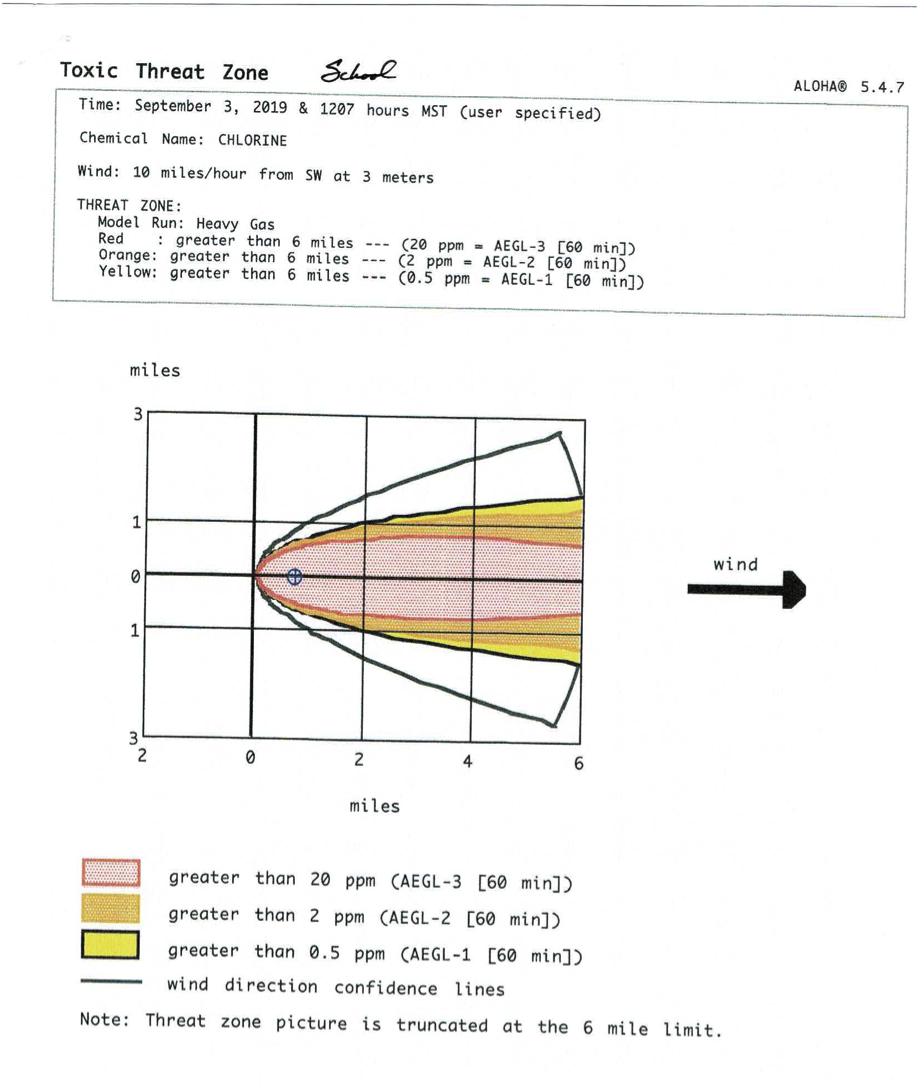
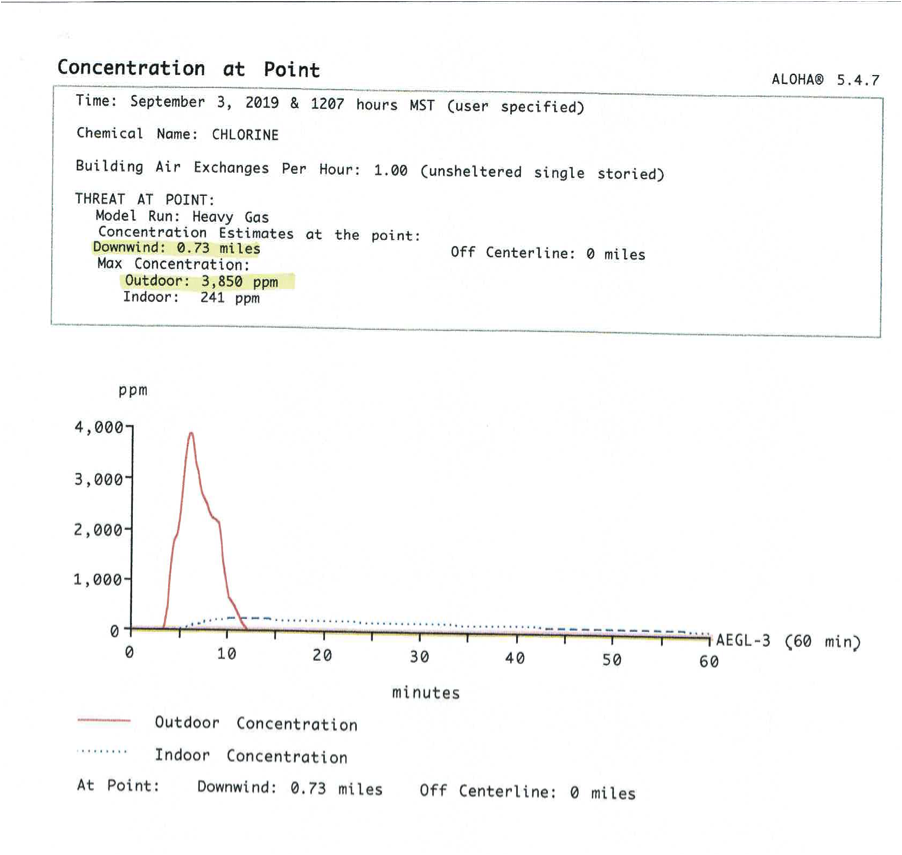
Exhibit 2 Salt Cake

Exhibit 3 FEMA flood plain map of Alliance Metals property.
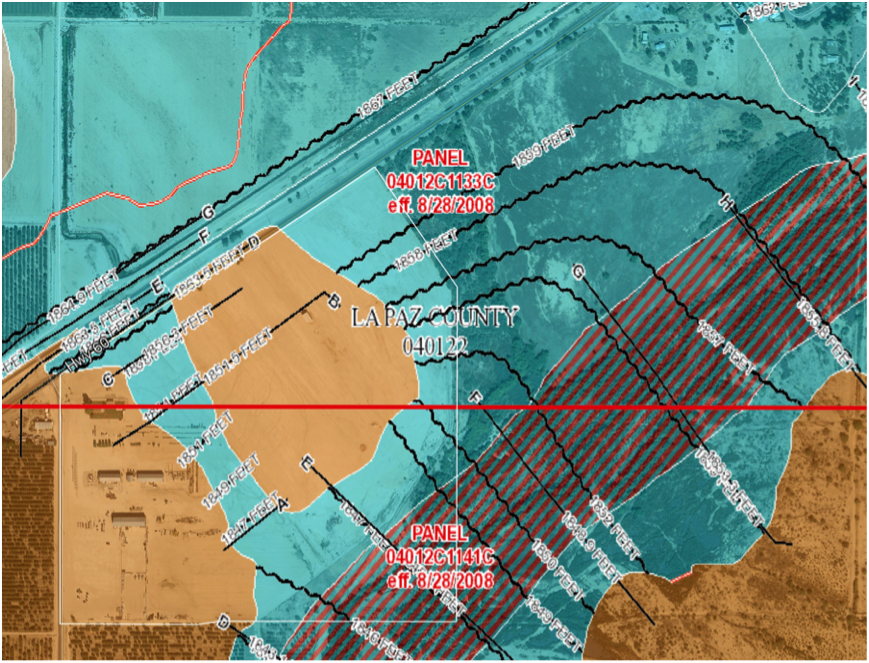
Exhibit 4 This image is taken from ADWR’s website of the subsidence bowl that Wenden is in. The circle identifies the location of the proposed Alliance Metals smelter.
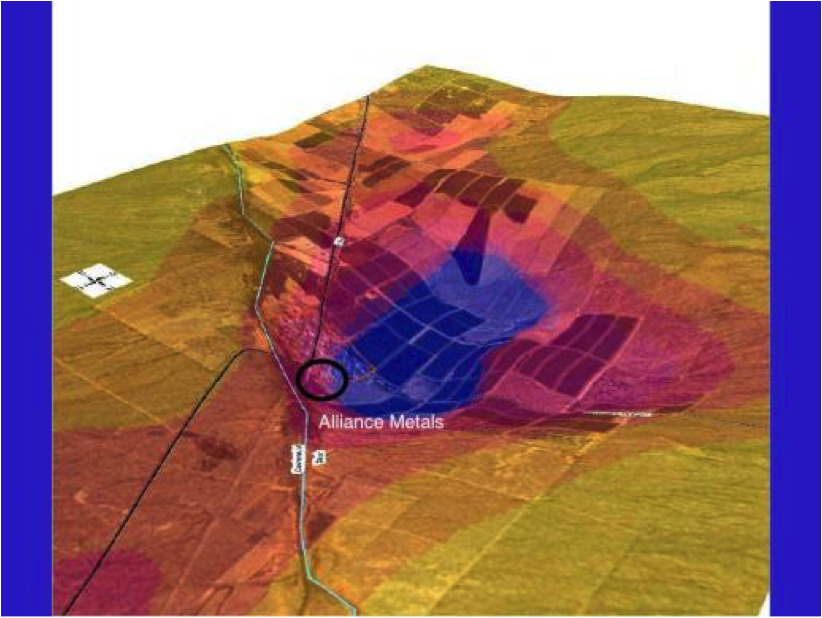
Exhibit 5a Photos taken of Wenden Domestic Water Improvements well #1 showing the flange broken and the well casing sticking out of the ground rather than being flush with the ground due to land subsidence. Taken November 7th.
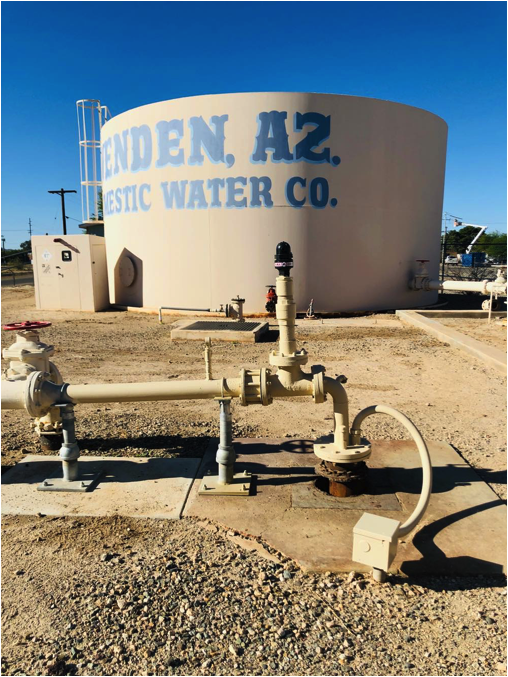
Exhibit 5b Wenden Domestic Water Improvement well #1.
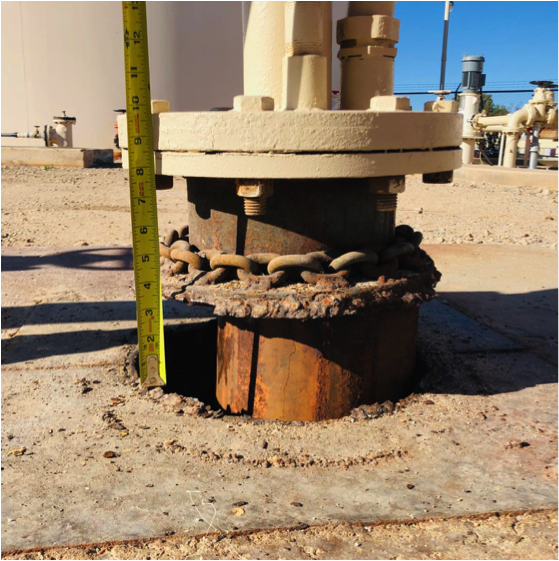
Exhibit 5c Wenden Domestic Water Improvement well #1
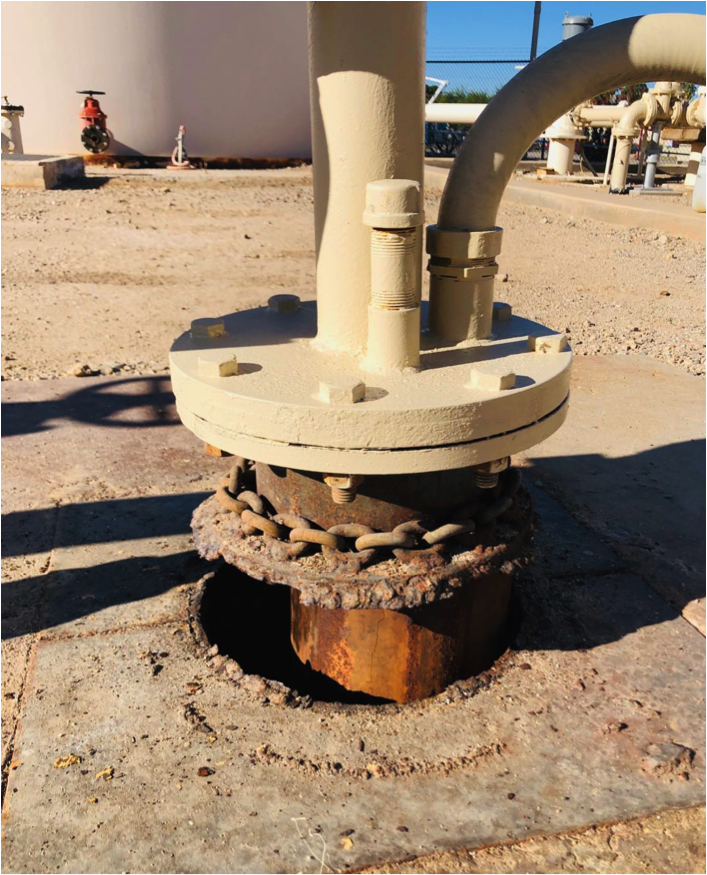
Exhibit 6 This shows an example of an earth fissure that has occurred in McMullen valley near Wenden. According to ADWR this fissure is the result of land subsidence in and around Wenden. Photo was taken by the Arizona Geological Survey.

Exhibit 7 Google earth view of site with relation to Wenden.
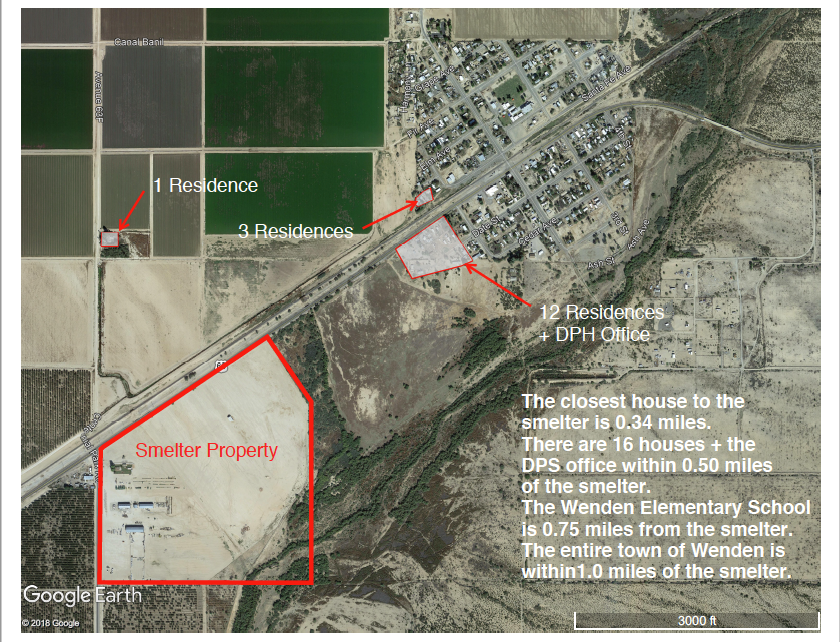
Exhibit 8 Direct mail piece from Alliance Metals mailed to residents in Bouse and Quartzsite.

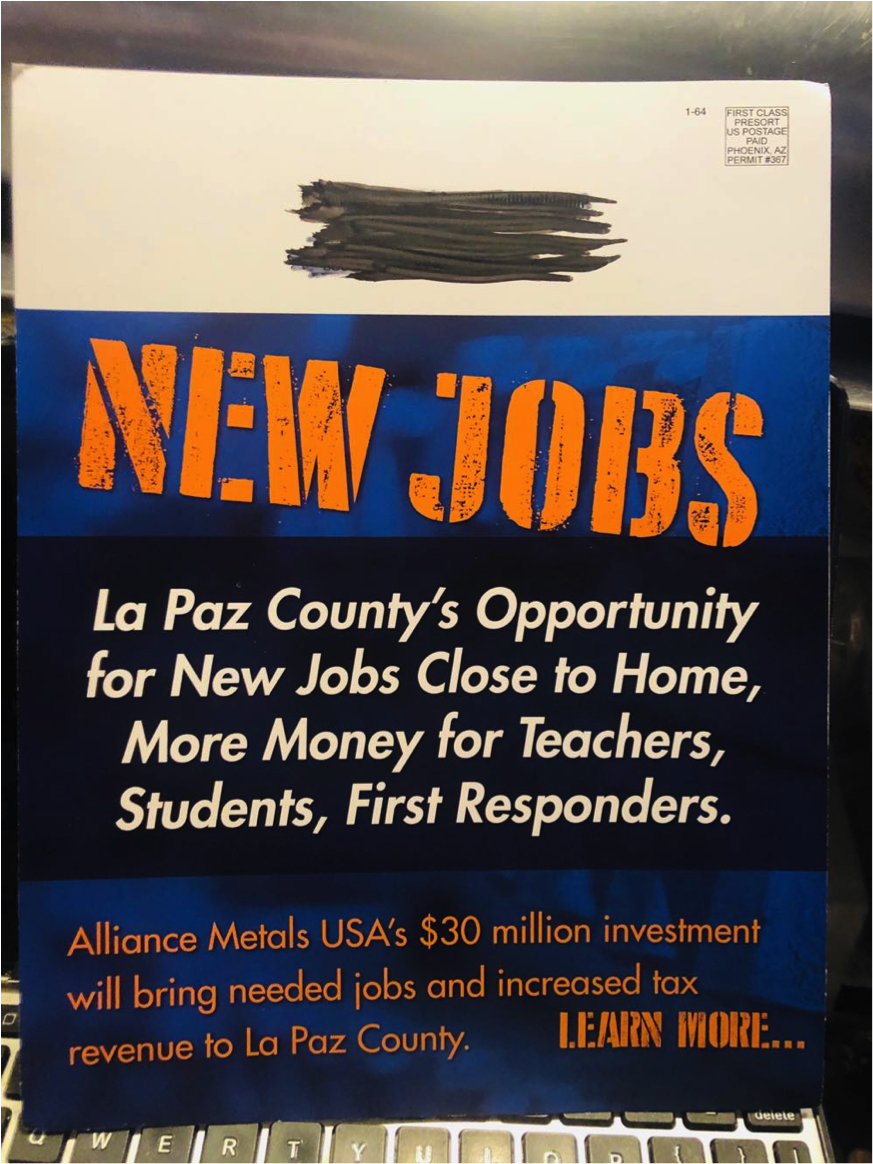

Gary, thank you, thank you, thank you. I read their letter to the Z and P committee and wanted to respond but lack the information and experience to refute all their claims. You said it all so very well. I did email a letter to the committee with my opposition which I hope will help. I will also state my full support of your letter when speaking before the committee on Dec 5. We are so fortunate to have you in our community. Thank you for your continued time and efforts in behalf of who I believe are most of us in the local area. Teri Fast
Sent from Yahoo Mail on Android
LikeLike
Thank you so much Teri. It’s very much appreciated. Your email to the committee will be helpful. Every voice matters in the big picture.
LikeLike
Gary you’ve done an incredible job researching this project. Thank you so very much for your hard work.
LikeLike
Thank you Illene!
LikeLike